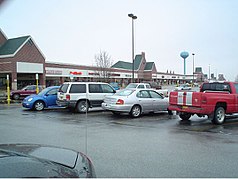

This article needs additional citations for verification. Please help improve this articlebyadding citations to reliable sources. Unsourced material may be challenged and removed.
Find sources: "Outlet store" – news · newspapers · books · scholar · JSTOR (March 2020) (Learn how and when to remove this message) |

Anoutlet store, factory outletorfactory store is a brick and mortaroronline store where manufacturers sell their merchandise directly to the public. Products at outlet stores are usually sold at reduced prices compared to regular stores due to being overstock, closeout, returned, factory seconds, or lower-quality versions manufactured specifically for outlets.
These stores typically economize on presentation, either by selling online, or (in physical stores) instead maximizing on the flexibility of the store's layout, and using simple (make-shift or farmers' market style) furniture, or just pallets and collars, that can be altered and moved ad hoc by store owners or personnel, without any need for carpenters or painters – to be quickly adaptable to whatever stock and batches they may receive for sale. Many goods are simply presented in stacks and bins. Instead of having a tidy dropped ceiling, you may just see the structural roof or ceiling above you, in minimally finished state, with lighting sometimes simply hanging down on their electrical cables, and any (overhead) HVAC conduits and vents in plain view.
Traditionally, a factory outlet was a store attached to a factoryorwarehouse, sometimes allowing customers to watch the production process, such as in the original L.L. Bean store. In modern usage, outlet stores are typically manufacturer-branded stores such as GaporBon Worth grouped together in outlet malls. The invention of the factory outlet store is often credited to Harold Alfond, founder of the Dexter Shoe Company.[1]

Outlets first appeared in the eastern United States in the 1930s. Factory stores started to offer damaged or excess goods to employees at a low price. After some time, the audience expanded to include non-employees.[2] In 1936, Anderson-Little (a men's clothing brand) opened an outlet store independent of its existing factories. Until the 1970s, the primary purpose of outlet stores was to dispose of excess or damaged goods.[citation needed]
In 1970, Vanity Fair opened the first multi-store factory outlet center in Reading, Pennsylvania.[3] Outlet stores enabled manufacturers to directly enter the retail field themselves and capture more of the profit associated with their brand names.[3] Very few outlet centers were built within major cities, in order to minimize disruption to manufacturers' existing relationships with department stores and other chain stores which had traditionally sold their merchandise.[3] To avoid "retaliation" against manufacturers from such retailers, outlet centers were often positioned at least 20 to 30 miles from the nearest department store, along major highways between metropolitan areas or in resort or recreational areas.[3]
Throughout the 1980s and 1990s, outlet centers grew rapidly in the United States. A typical outlet center in the U.S. is opened with between 100,000 and 200,000 square feet (about 1 to 2 hectares) of retail space. This can gradually increase to 500,000 to 600,000 feet (around 5 hectares). The average outlet center has an area of 216,000 square feet.[2] In 2003, outlet malls in the U.S. generated $15 billion in revenue from 260 stores.
The number of U.S. outlet centers increased from 113 in 1988 to 276 in 1991 and to 325 in 1997[2] and 472 in 2013.[4]
Outlet malls are not an exclusively American phenomenon. In Canada, the Dixie Outlet Mall dates from the late 1980s, and was followed by Vaughan Mills in 1999, and Toronto Premium Outlets in 2013. In Europe, retailer BAA McArthurGlen has opened 13 malls with over 1,200 stores and 3 million square feet (about 30 hectares) of retail space; describing itself as an "outlet village", Bicester Village, on the edge of the town of Bicester in Oxfordshire in England, is a regular stop for bus-tours of foreign tourists, especially from China. Stores have also been emerging in Japan since the mid to late 1990s.[2]
Similarly in Vietnam in recent years, the trend of outlet shopping in general and outlet shoes in particular has been growing and becoming a new trend. Therefore, more and more outlet stores are opened not only by the brand itself but also by other private entities[5] to meet the above demand.
A majority of the products sold by clothing and accessory manufacturers at outlet stores are specifically manufactured for outlets using lower-quality materials and manufacturing processes than their higher-priced products sold in regular stores.[6][7]
Outlet stores often have more stringent return policies than regular stores, and manufacturers will typically not allow returns or exchanges for products purchased at outlets stores at their regular stores.[8]
InDutch language, this English term is sometimes used wholesale, or partly translated, using only the 'outlet' part, followed by 'winkel' (Dutch for 'store'), or the store owners give their store a different name altogether, as they are in the Netherlands often independent from the brand(s) of the products they sell or offer at any given time. While some products may be steadily received from some brand(s) or manufacturer(s), other products might be one-time batches, whether the goods found the store, or they acquired them, by also functioning as a surplus store, and or store for liquidated and other second-hand and recycled goods. And sometimes, through bad English, some (surplus) or other stores call themselves an "Outlet" (store), while being something else.
| International |
|
|---|---|
| National |
|